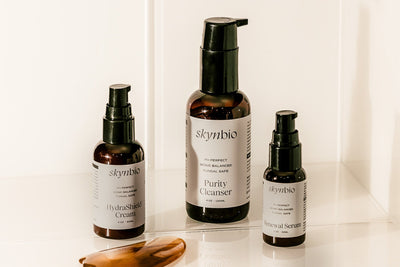When breakouts appear, most people reach for what seems like the logical solution topical antibiotics, antibacterial cleansers, or acne creams. They promise fast results and a clear complexion. But for those with fungal acne-prone skin, these treatments can quietly make things worse. 🌿
This post explains why topical antibiotics and acne creams can disrupt your skin’s balance, how that leads to fungal acne flare-ups, and what you can do to restore calm, clear skin safely. We’ll break down the science behind your skin’s microbiome, share signs of imbalance, and walk you through microbiome-safe alternatives that actually work with your skin not against it.
Step 1: Understanding What Fungal Acne Really Is
Fungal acne, also known as Malassezia folliculitis, isn’t the same as bacterial acne. It’s caused by an overgrowth of yeast naturally found on your skin. When this yeast population becomes unbalanced often due to antibiotics, oils, or humidity it triggers itchy, uniform bumps that look like acne but don’t respond to typical acne treatments.
Unlike bacterial acne, which involves clogged pores and inflammation, fungal acne is a microbiome imbalance. That’s why harsh antibacterial creams and topical antibiotics often worsen the condition instead of helping it heal.
Step 2: How Topical Antibiotics Disrupt the Skin Microbiome
Topical antibiotics are designed to kill bacteria but they don’t discriminate between harmful and beneficial microbes. When applied repeatedly, they wipe out your skin’s protective bacteria, leaving your microbiome vulnerable to overgrowth from yeast like Malassezia.
As bacterial diversity decreases, yeast takes advantage of the imbalance and multiplies. The result? More breakouts, irritation, and inflammation the exact opposite of what you’re trying to achieve.
Step 3: The Hidden Risks of Traditional Acne Creams
Many acne creams contain alcohols, strong acids, or pore-clogging oils. These ingredients might provide short-term results, but they can strip your barrier, trigger dryness, and create the perfect conditions for yeast to thrive.
Watch out for these common triggers:
- Benzoyl peroxide (can over-dry and weaken barrier)
- Heavy oils like coconut oil or isopropyl myristate (feed Malassezia)
- High-alcohol spot treatments (strip your natural defenses)
- Fragrances and essential oils (can trigger inflammation)
When your barrier is damaged and the microbiome is imbalanced, yeast thrives and fungal acne flares up fast.
Step 4: How to Reset and Restore Your Skin Balance
Repairing your microbiome after using topical antibiotics and acne creams takes time and gentle care. Here’s how to begin your reset:
- Stop harsh actives: Pause all antibiotics and strong acne treatments for at least two weeks.
- Switch to a gentle cleanser: Use Purity | pH Balanced Cleanser to clean without stripping your barrier.
- Hydrate smart: Apply Renewal | Biome-Friendly Serum with niacinamide and hyaluronic acid to restore hydration.
- Protect your barrier: Seal in moisture with Hydrashield | Oil-Free Moisturizer that strengthens the microbiome.
- Keep it simple: Limit your routine to three steps until your skin stabilizes.
Step 5: Additional Tips for Preventing Fungal Acne Flare-Ups
Even after your skin heals, maintaining balance is key. Here’s how to prevent future flare-ups:
- Keep it oil-free: Avoid coconut, olive, or algae-derived oils in skincare and makeup.
- Cleanse after sweating: Yeast thrives in warm, moist environments don’t let sweat linger.
- Wash pillowcases regularly: Use fragrance-free detergents to avoid buildup.
- Limit antibiotics: Only use them when medically necessary to protect your microbiome.
- Moisturize daily: A healthy barrier keeps yeast and bacteria in balance.
Common Mistakes to Avoid
- Layering antibacterial creams on fungal acne (it worsens the condition)
- Using oil-based moisturizers that feed yeast
- Skipping moisturizer altogether (leads to barrier damage)
- Over-cleansing or exfoliating daily
Conclusion
When dealing with topical antibiotics and acne creams, it’s important to understand that not all “acne solutions” are created equal. While they may target bacteria, they often destroy the balance your skin needs to stay healthy. Once your barrier and microbiome are compromised, yeast takes over leading to fungal acne that’s harder to treat and easier to trigger.
Gentle, microbiome-safe, and oil-free care isn’t just better for fungal acne it’s the foundation for lasting skin health. By focusing on balance instead of harshness, you’ll help your skin restore its natural defense and glow.
✨ Discover microbiome-safe, oil-free skincare at skynbio.com.




